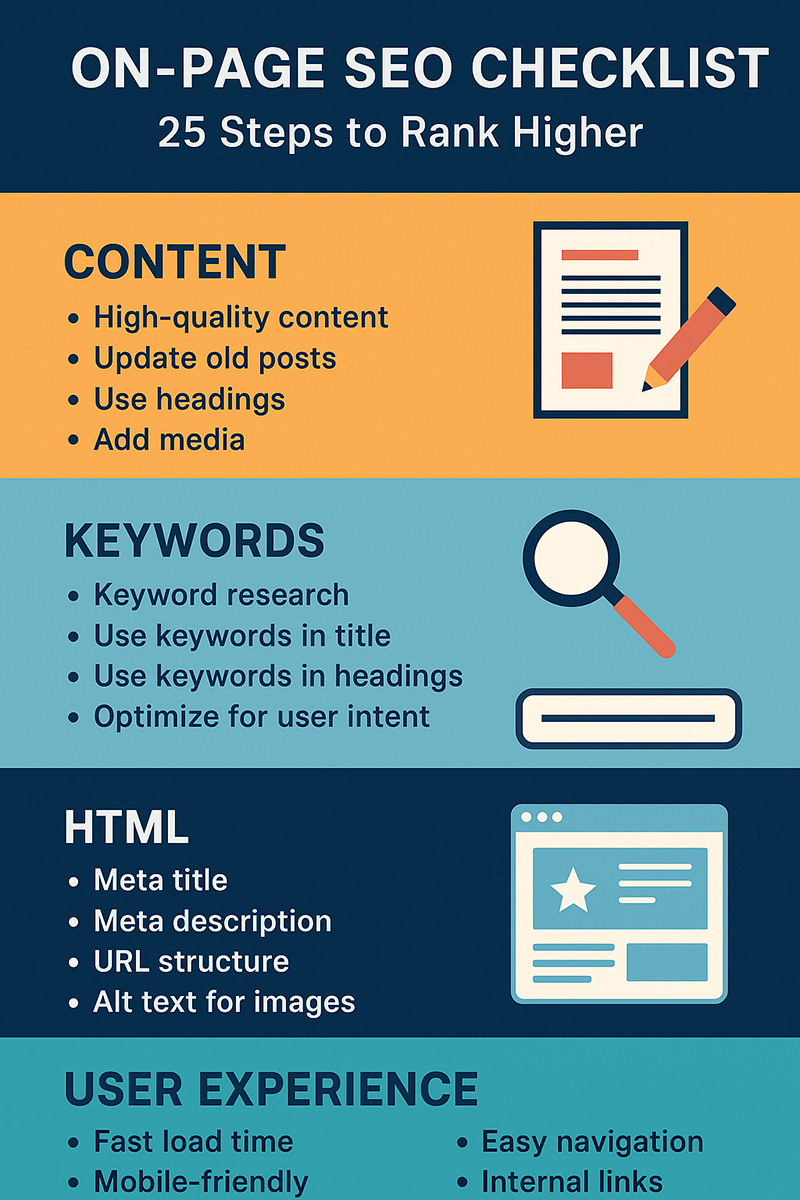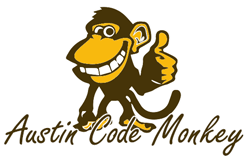If you want to rank on Google, you need more than just great content—you need on-page SEO.
On-page SEO is the practice of optimizing individual pages on your site so that search engines understand them and users find them valuable. It’s one of the core pillars of SEO, alongside technical and off-page SEO.
This guide provides a 25-step on-page SEO checklist you can follow to improve your rankings and visibility.
Dive into the essentials of on-page SEO and learn why it’s critical for boosting your website’s visibility and user experience. This episode breaks down Austin Code Monkey’s 25-step checklist, covering title tags, meta descriptions, and content optimization to drive higher search engine rankings and conversions.
What is On-Page SEO?
On-page SEO refers to all the optimizations you make directly on your website’s pages to improve rankings. This includes content, HTML tags, URLs, internal links, and user experience.
Unlike off-page SEO (which focuses on backlinks and authority), on-page SEO gives you direct control over how your site appears to both search engines and users.
👉 Related: What is SEO? A Beginner’s Guide to Search Engine Optimization
👉 Related reading: How to Local SEO in 2025? A Beginner’s Guide to Search Engine Optimization
Why On-Page SEO Matters
-
Improves rankings: Google uses page-level signals to determine relevance.
-
Boosts user experience: Optimized content is easier to read and navigate.
-
Drives conversions: A clear, structured page helps guide visitors toward action.
-
Supports technical SEO & link building: Strong on-page SEO amplifies other strategies.
👉 Related: How Search Engines Work: Crawling, Indexing, and Ranking Explained
✅ On-Page SEO Checklist: 25 Steps
Here’s the complete 25-step checklist you can copy, paste, and implement today.

1. Use a Target Keyword in the Title Tag
-
Keep under 60 characters.
-
Place the keyword near the beginning.
2. Write a Compelling Meta Description
-
150–160 characters.
-
Include your target keyword.
-
Write for clicks, not just search engines.
3. Optimize Your URL Structure
-
Short, descriptive, and keyword-rich.
-
Example:
www.yoursite.com/on-page-seo-checklist
4. Use a Single H1 Tag per Page
-
Should contain the target keyword.
-
Must be descriptive of the page content.
5. Use Proper Heading Hierarchy (H2, H3)
-
Organize content logically.
-
Include secondary keywords in subheadings.
6. Add Your Keyword in the First 100 Words
Google places more weight on early mentions of the keyword.
7. Use LSI & Semantic Keywords
Include related terms naturally to improve topical relevance.
8. Optimize Content Length
-
Aim for 1,500–2,500 words for competitive keywords.
-
Cover topics in-depth, answering related questions.
9. Improve Readability
-
Use short paragraphs (2–4 sentences).
-
Add bullet points, lists, and visuals.
-
Write at an 8th-grade reading level.
10. Add Internal Links
-
Link to relevant blog posts and service pages.
-
Use descriptive anchor text (avoid “click here”).
👉 Related: Why Your Website Isn’t Ranking on Google
11. Add External Links to Authoritative Sources
-
Link to high-authority sites for credibility.
-
Example: Wikipedia, government, or industry sources.
12. Optimize Images with Alt Text
-
Use descriptive alt tags with keywords.
-
Compress images for faster load times.
13. Use Multimedia for Engagement
-
Add images, videos, infographics, or charts.
-
Breaks up text and improves dwell time.
14. Optimize for Featured Snippets
-
Use questions as subheadings.
-
Provide clear, concise answers in bullet points.
15. Add a Table of Contents (for Long Posts)
-
Improves navigation.
-
Increases chances of jump links in search results.
16. Use Schema Markup
-
Add FAQ, How-To, Review, or Local Business schema.
-
Increases SERP visibility.
17. Optimize for Mobile
-
Responsive design is mandatory.
-
Test with Google’s Mobile-Friendly Test.
18. Improve Page Speed
-
Use Google PageSpeed Insights.
-
Compress images, enable caching, use a CDN.
👉 Related: Technical SEO Audit Guide for Beginners
19. Secure Your Website with HTTPS
SSL is a ranking signal and builds user trust.
20. Avoid Keyword Stuffing
Use keywords naturally—Google penalizes over-optimization.
21. Use Clean & Descriptive Anchor Text
Instead of “click here,” use “see our SEO services in Austin.”
22. Add Social Sharing Buttons
Encourage users to share your content for more visibility.
23. Optimize for Core Web Vitals
-
LCP (Largest Contentful Paint) under 2.5 seconds
-
FID (First Input Delay) under 100ms
-
CLS (Cumulative Layout Shift) under 0.1
24. Create Engaging CTAs (Calls-to-Action)
Guide users toward signing up, contacting you, or buying.
25. Regularly Update Content
Keep posts fresh with new statistics, links, and insights.
Internal Linking Strategy & Anchor Texts
This blog post is a supporting pillar under your SEO hub.
Parent Pillar:
Related Supporting Pillars:
Recommended Anchor Texts:
-
“on-page SEO checklist” → this post
-
“how search engines work” → link to engine explainer
-
“technical SEO audit” → link to audit guide
-
“why your website isn’t ranking” → link to ranking issues post
-
“link building strategies” → link to link building guide
This pillar-cluster map builds topical authority and strengthens internal linking.
Austin Code Monkey’s SEO Services
At Austin Code Monkey, we don’t just create websites—we optimize them to rank higher.
Our SEO services include:
-
On-page SEO audits & implementation
-
Keyword research & content optimization
-
Technical SEO fixes (speed, indexing, mobile)
-
Local SEO strategies for Austin businesses
-
Link building & content marketing
If you want your website to outrank competitors and attract qualified leads, we can help.
👉 Explore Austin Code Monkey’s SEO Services and get started today.
Conclusion
On-page SEO is the foundation of higher rankings. By following this 25-step checklist, you’ll improve visibility, user experience, and conversions.
But SEO is never “set it and forget it.” It requires consistent updates, technical fine-tuning, and strategic optimization.
Need expert help? Partner with Austin Code Monkey—your trusted SEO partner in Austin.
Austin Code Monkey Delivers SEO Services in Austin, TX
Austin Code Monkey offers tailored SEO services for businesses in Austin, Texas, specializing in On-Page, Off-Page, and Technical SEO to boost online visibility. Their expert team focuses on ethical White Hat strategies, including keyword research, content optimization, and link building, to drive sustainable growth. Visit austincodemonkey.com to discover how their customized solutions can elevate your business in search engine rankings and attract more traffic.
Contact Austin Code Monkey For
Local and Nationwide On-Page SEO Services at 737-932-7532

